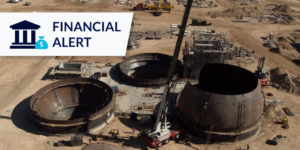
Baton Rouge, Louisiana contractor MMR Constructors, Inc. filed a lawsuit against three corporations on April 16, 2021, alleging non-payment and damages totalling $2,542,338.68 stemming from the construction of the Wildhorse Terminal Project in Lincoln County, Oklahoma.
The lawsuit claims that MMR Constructors was hired as a subcontractor by general contractor Matrix Services, Inc. in December 2019 to provide supervision, labor, material, equipment, and temporary facilities and utilities for project and property owner Keyera Energy, Inc.
However, following the completion of this work, MMR Constructors have allegedly yet to be paid, stating that as of January 2021, they were owed $1,775,558.68 for services rendered per the terms of the subcontract. They further cite $766,780 for impact costs stemming from delays, interference, and breaches of contract, as well as additional attorney’s fees, costs, and interest.
As a result of Keyera Energy and Matrix Services’ non-payment, MMR Constructors filed a mechanics lien on January 7, 2021 totalling $1,589,070.21 for materials and services last rendered on October 21, 2020. A separate claim made by MMR Constructors for $204,616.29, also filed on January 7, has since been released.
The third defendant, Fidelity and Deposit Company of Maryland, bonded off MMR Constructors’ lien on February 25, 2021.
Bonding off a mechanics lien substitutes a surety bond for a specified property, replacing the value of the lien filed against it. In this situation, the surety bond is substituted for the property, and becomes the subject of the claim for non-payment.
Normally, this process ensures that proceeds recovered from a claim will not come from foreclosure of the property. However, as part of its first count of the filed lawsuit, MMR Constructors is seeking to foreclose on the mechanics lien despite its bonding, asserting that its right to foreclose takes precedent and that it is entitled to have the project’s property sold in order to satisfy its claims and attorneys’ fees.
MMR Constructors’ lawsuit cites that, barring the lien’s foreclosure, “Keyera Energy and Matrix Services have been and will continue to be unjustly enriched, to the impoverishment of MMR Constructors, if MMR Constructors is not paid the reasonable value of the goods and services it provided for use in the construction and improvement of the Project.”
According to Levelset construction lawyer Alex Bennaroche, this is a valid claim: “Bonding-off a lien just substitutes the security [bond] for the property,” Benarroche said. “In Oklahoma the claimant ‘must proceed against the substituted security in the same time and manner as is required for foreclosure of a lien claim;’ which is generally the same rule in most states.”
While the filing of a mechanics lien is normally enough to prompt payment, claimants sometimes may have to initiate a lien foreclosure action in order to enforce the lien. If a foreclosure action is successful, this can result in the judge ordering the sale of the property to satisfy the debt.
In this case, it’s worth noting that Oklahoma lien law requires claimants to wait 90 days before enforcing a lien, and allows for the opportunity to file a notice of intent to foreclose so that payment disputes can be settled, making enforcement a last resort.
Lawsuit a possible indicator of long-term financial troubles surrounding oil and gas industry
Keyera Energy and Matrix Services’ problem with non-payment could be indicative of larger-spread financial issues in the North American oil and gas industry. According to an April 15, 2021 report by law firm Haynes and Boone — which has monitored North American oil and gas producer bankruptcies since 2015 — Chapter 11 bankruptcies of North American oil producers in quarter one of 2021 have risen to their highest first financial quarter levels since 2016.
Energy firms are still struggling to recover from the 2020 oil crisis and other issues surrounding the COVID-19 pandemic. From January 1–March 31, 2021, eight North American oil and gas producers declared Chapter 11 bankruptcy, constituting a rise when compared to the five declared in the first quarter of 2020 (and the highest amount since 17 were declared in the first quarter of 2016).
While the aggregate debt for the quarter was also the second-lowest since Haynes and Boone have collected data ($1.8 billion, slightly behind $1.6 billion in quarter one of 2019), evidence points to the brunt of hardships falling upon smaller firms. The majority of filings for the quarter came from smaller firms, with the largest debt-holder for the quarter, HighPoint Resources Corp., holding $905 million in secured and unsecured debts.
Though this trend may be indicative of the financial difficulties felt by many within the oil and gas industry, Chapter 11 bankruptcy is typically used to provide for a corporation’s ability to reorganize, allowing a debtor to maintain its business and pay creditors over time — leaving a window of hope open for these companies’ recovery.